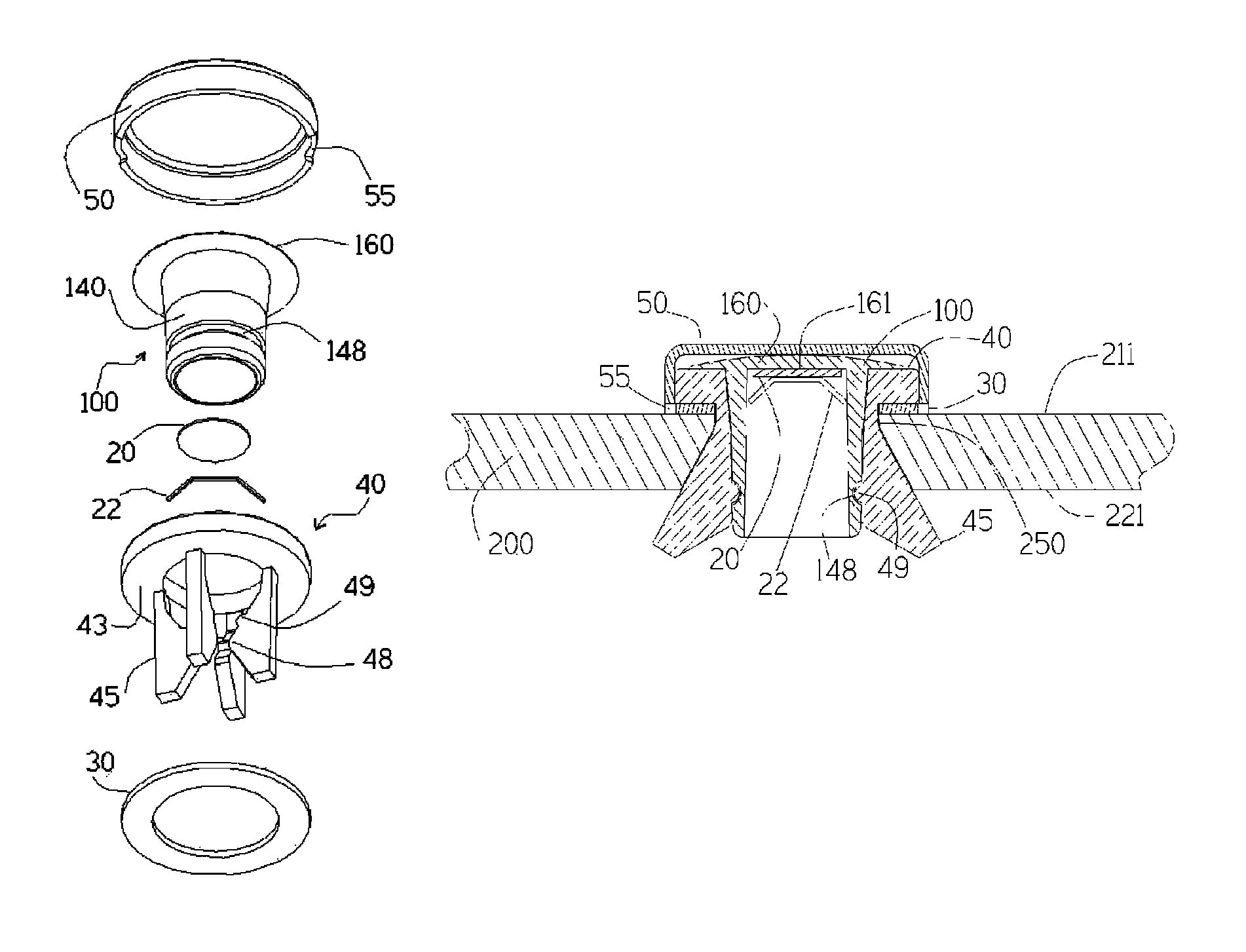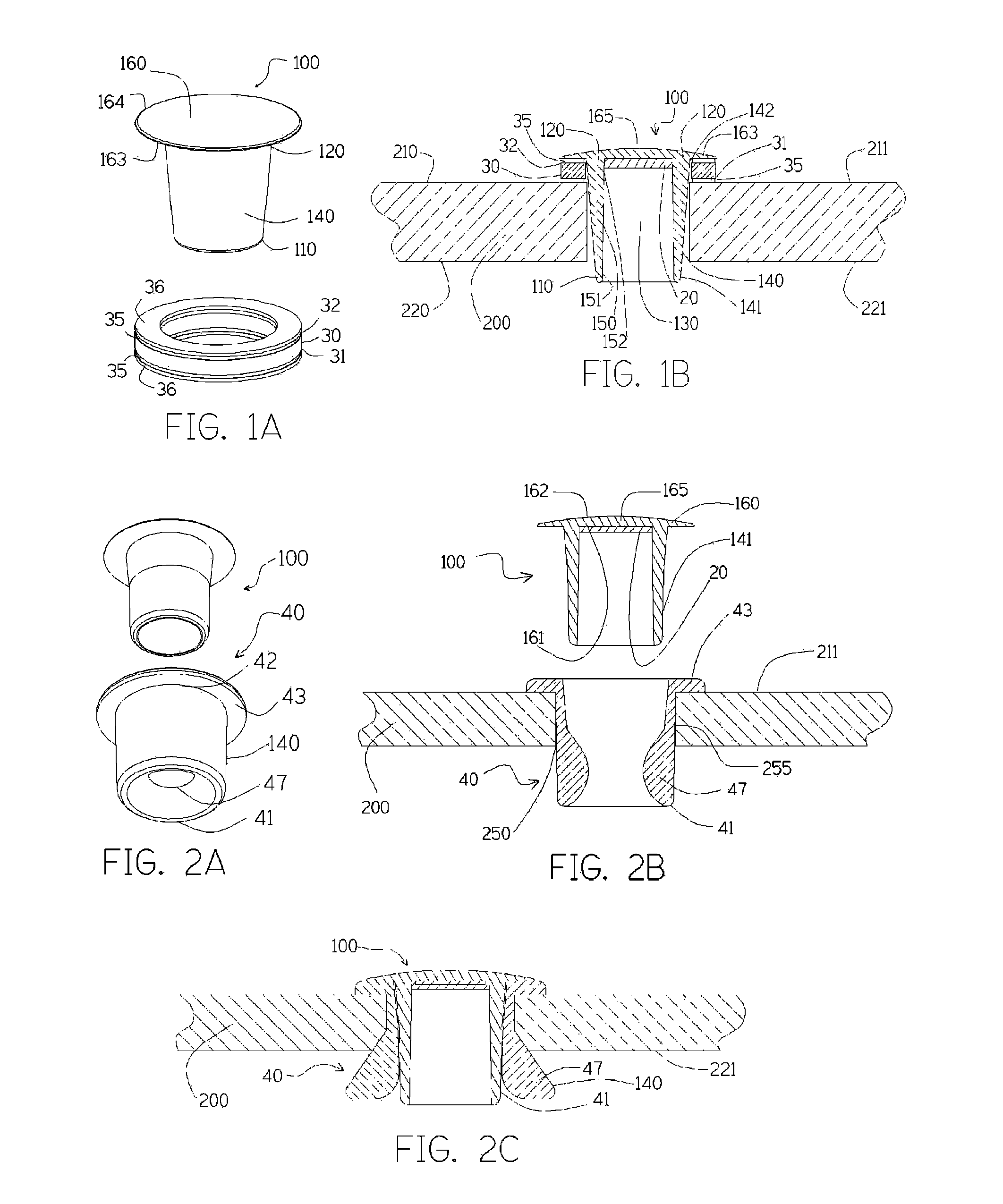Low cost humidity and mold indicator for buildings
a technology for humidity and mold indicators, which is applied in the direction of moisture content analysis, specific gravity measurement, instruments, etc., can solve the problems of rot in the roof deck, rot in the joists, and similar damage to walls, ceilings and soffits, etc., to achieve easy installation of the device, and easy removal of the devi
- Summary
- Abstract
- Description
- Claims
- Application Information
AI Technical Summary
Benefits of technology
Problems solved by technology
Method used
Image
Examples
second embodiment
[0058]FIG. 2A illustrates the present invention. Soft plastic retainer 40 is a hollow elongate cylinder with an integral flange 43 that contacts the exterior panel surface 211 when the retainer 40 is inserted into a hole 250 in the panel 200 as illustrated by FIG. 2B. Body 100 is inserted into the retainer 40 after the retainer 40 is in the panel 200. The wall thickness 47 of the retainer 40 at its first end 41 is greater than the difference between the diameter 255 of the hole 250 and the exterior diameter 141 of the body 100. FIG. 2C illustrates the exterior surface 140 of the retainer 40 forced outward against the interior surface 221 of the panel 200 when the body 100 is inserted, thereby securing and sealing the body 100 in the panel 200.
[0059]FIG. 2B also illustrates the exterior surface 162 and interior surface 161 of the disc-shaped closure 160 create a convex lens 165 to magnify viewing of chemical 20.
third embodiment
[0060]FIG. 3A illustrates the present invention. A disposable seal 70 slides over the first end 110 of the body 100 to prevent ambient humidity from changing the chemical 20 during storage and transport. The seal 70 is configured to be larger than the hole 250 in the panel 200 to make certain the installer removes the seal 70 before installation of body 100 into the panel 200.
[0061]Mask 60 prevents paint from coating the entire exterior surface 162 if housing 100 is painted. The mask 60 is removed and disposed after painting or after installation.
[0062]Ventilation openings illustrated by ventilation slots 111 extend between the external cylindrical surface 140 to the internal cylindrical surface 150 of the body 100 adding another path for air to reach the humidity chamber 130. FIG. 3B illustrates body 100 installed in a panel 200. Insulation 300 or other building materials that contact or block open end 110 of the body 100 cannot seal off the humidity chamber 130 because air can tra...
fourth embodiment
[0065]FIG. 4A illustrates the present invention. Fingers 112 are attached at the closed end 120 of body 100 and are able to flex radially inward at the open end 110 of the body 100.
[0066]FIG. 4B illustrates the body 100 installed in a panel 200. Protrusions 113 extend radially outward to a radius greater than the radius of the panel hole 250. The protrusions 113 are forced inward they are inserted into the hole 250 and spring back out as they exit the hole 250 on the interior side 221 of the panel 200. This secures the body 100 in the panel 200. Dimensions of the fingers 112 and the gasket 30 are selected so that the gasket 30 is compressed and the body 100 is well secured in a building panel 100 of a standard thickness.
PUM
| Property | Measurement | Unit |
|---|---|---|
| relative humidity | aaaaa | aaaaa |
| transparent | aaaaa | aaaaa |
| diameter | aaaaa | aaaaa |
Abstract
Description
Claims
Application Information
 Login to View More
Login to View More - R&D
- Intellectual Property
- Life Sciences
- Materials
- Tech Scout
- Unparalleled Data Quality
- Higher Quality Content
- 60% Fewer Hallucinations
Browse by: Latest US Patents, China's latest patents, Technical Efficacy Thesaurus, Application Domain, Technology Topic, Popular Technical Reports.
© 2025 PatSnap. All rights reserved.Legal|Privacy policy|Modern Slavery Act Transparency Statement|Sitemap|About US| Contact US: help@patsnap.com



